Motorcycle transmissions are systems that transfer power from the engine to the wheels. They can be manual, requiring gear shifts via a clutch, or automatic, shifting gears without rider input. Understanding these systems is crucial for riders to optimize performance, safety, and comfort, whether commuting or riding off-road.
Brief Overview
Motorcycles can feature either manual or automatic transmissions. Manual transmissions require riders to shift gears using a clutch and gear lever, offering precise control. Automatic motorcycles, including semi-automatic and continuously variable transmissions (CVTs), shift gears without manual input, providing ease of use. Both systems efficiently transfer engine power to the wheels, catering to different riding preferences and skill levels.
Historical Context
Motorcycle transmissions have evolved significantly since their inception. Early motorcycles in the 1900s relied on basic manual systems, with riders shifting gears using hand-operated levers. Automatic transmissions emerged in the mid-20th century, offering convenience for urban riders. The 1950s and 60s saw the rise of semi-automatic and fully automatic systems, with models like the Honda Cub popularizing ease of use. This historical progression reflects the industry’s adaptation to rider needs and technological advancements.
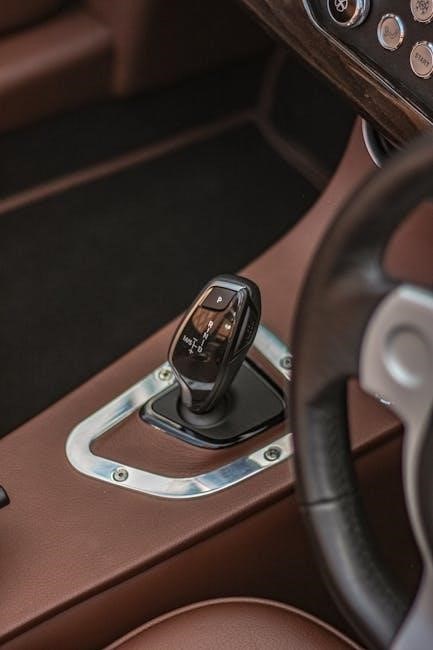
Understanding Manual Transmissions
Manual transmissions require a clutch and gear lever to shift gears, providing precise control over speed and torque, favored by experienced riders.
Components of a Manual Transmission
A manual transmission consists of a clutch, gear lever, and gearbox. The clutch, operated by a hand or foot lever, disconnects the engine from the transmission. The gear lever, typically located on the footpeg, allows riders to manually shift gears. Inside the gearbox, gears and bearings work together to transfer power to the wheels. These components require precise coordination for smooth operation, making manual transmissions popular among experienced riders for their control and efficiency.
How Manual Transmissions Work
A manual transmission operates by disconnecting the engine from the transmission via the clutch. When the rider presses the clutch, they can shift gears using the gear lever. Releasing the clutch slowly reconnects the engine to the transmission, providing power to the wheels. Proper timing and coordination between the clutch and throttle ensure smooth acceleration and gear changes, allowing riders to control speed and torque effectively, especially in varying riding conditions.
Advantages of Manual Motorcycles
Manual motorcycles offer precise control over gear shifts, allowing riders to optimize engine performance. They typically have lower purchase prices and higher fuel efficiency compared to automatics. The ability to shift gears manually provides better acceleration and deceleration, especially in stop-and-go traffic or on winding roads. Additionally, manual transmissions often require less maintenance, making them a cost-effective choice for experienced riders seeking a more engaging and economical option. This makes them popular among enthusiasts and commuters alike.
Disadvantages of Manual Motorcycles
Manual motorcycles require constant engagement with the clutch and gear lever, which can be physically demanding in heavy traffic. They demand more skill and practice, making them less accessible to beginners. Stalling is common among new riders, and frequent gear shifting can be exhausting. Additionally, manual transmissions may require more maintenance, particularly for the clutch, and can be less convenient in stop-and-go urban environments, making them less appealing for casual or relaxed riders.
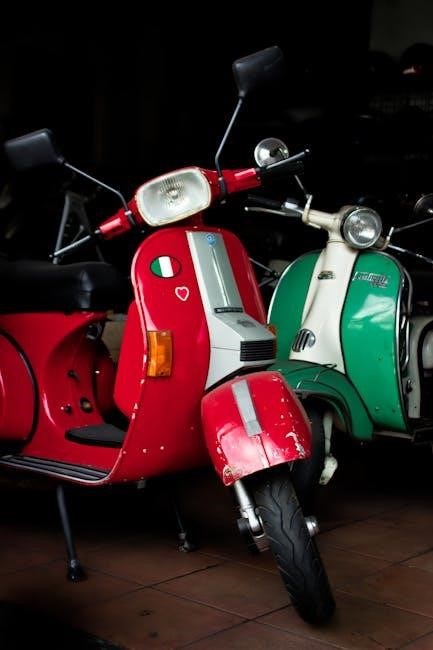
Exploring Automatic and Semi-Automatic Transmissions
Automatic and semi-automatic transmissions simplify riding by eliminating manual gear shifting, offering ease of use for commuters and beginners while reducing rider fatigue in traffic conditions;
What Are Automatic Motorcycles?
Automatic motorcycles feature transmissions that shift gears automatically, eliminating the need for manual clutch operation. They are ideal for beginners and urban commuting, offering ease of use and reducing rider fatigue. These bikes typically use systems like belt-driven CVTs or dual-clutch technology to provide seamless power delivery without manual intervention, making them accessible and stress-free for new riders in heavy traffic conditions.
How Semi-Automatic Transmissions Function
Semi-automatic transmissions combine elements of manual and automatic systems, allowing riders to shift gears without a clutch. These systems often use a foot pedal or button to change gears, while sensors and actuators handle the clutch engagement automatically. This design reduces rider fatigue, especially in heavy traffic, while still providing control over gear selection for a smoother and more efficient riding experience.
Benefits of Automatic Motorcycles
Automatic motorcycles offer ease of use, especially for beginners, as they eliminate the need for manual gear shifting and clutch operation. This reduces rider fatigue and allows focus on road awareness and control. Automatics are ideal for urban commuting, heavy traffic, and low-speed maneuvers. They also provide a smoother riding experience and are less intimidating for new riders, making them a practical choice for everyday use.
Drawbacks of Automatic Motorcycles
Automatic motorcycles often lack the control and precision of manual transmissions, which can be a drawback for experienced riders seeking sporty performance. They may also weigh more and consume more fuel, reducing efficiency. Additionally, automatics can be less common and more expensive than manual models, limiting availability and increasing purchase costs. This makes them less appealing for enthusiasts who value handling and cost-effectiveness.

Learning to Ride a Manual Motorcycle
Mastering a manual motorcycle requires practice, starting with clutch control and gear shifts in a safe, open area. Riders learn to coordinate throttle and brakes smoothly.
Steps to Learn Manual Transmission
- Find a safe, open space like an empty parking lot to practice without obstacles.
- Understand the clutch and gearshift operation, starting with the motorcycle in neutral gear.
- Practice slowly releasing the clutch while applying the throttle to feel the “biting point.”
- Shift gears gradually, using the clutch each time, and listen to engine RPMs for timing cues.
- Start with first gear, then progress to higher gears, ensuring smooth transitions.
- Focus on coordination between the clutch, throttle, and brakes for seamless control.
Regular practice builds muscle memory and confidence in mastering manual transmission.
Common Challenges Faced by Beginners
- Mastering the clutch-lever control to avoid stalling the motorcycle.
- Coordinating gear shifts with throttle input for smooth acceleration.
- Understanding when to shift gears based on engine RPM and speed.
- Managing the balance between clutch release and throttle application.
- Overcoming the initial difficulty of multitasking while maintaining focus on the road.
Patience and consistent practice are essential to overcoming these challenges and becoming proficient with manual transmission motorcycles.
Tips for Mastering the Clutch
- Start in a flat, open area to practice clutch control without obstacles.
- Release the clutch slowly and feather it gently for smooth gear engagement.
- Use the clutch and throttle together gradually to avoid jerky starts.
- Practice shifting gears at low RPM to minimize stalling.
- Avoid riding with the clutch partially engaged, as it can wear down the clutch and cause overheating.
Consistent practice and focus on smooth, deliberate movements will help build muscle memory and improve clutch control over time.
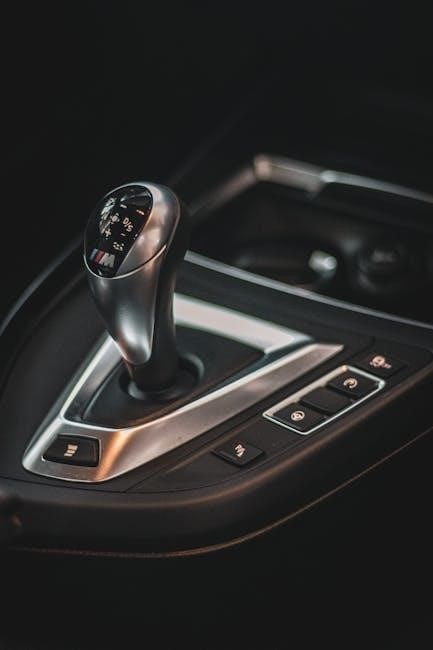
Learning to Ride an Automatic Motorcycle
Automatic motorcycles simplify the learning process by eliminating manual shifting, allowing beginners to focus on balance and control without clutch coordination, making the experience more accessible and less intimidating.
Ease of Learning for Beginners
Automatic motorcycles are easier for beginners as they eliminate the need to manually shift gears, reducing complexity and allowing riders to focus on balance, braking, and acceleration. This simplicity minimizes intimidation and allows new riders to build confidence and master fundamental riding skills without the added challenge of clutch coordination.
Differences in Riding Technique
Riding an automatic motorcycle differs significantly from a manual, primarily in gear shifting and clutch usage. Automatics require less hand and foot coordination, allowing riders to focus on steering and braking. Manuals demand precise clutch control and timely gear shifts, which enhances acceleration and performance but requires more skill and practice, especially in traffic or uphill terrain.
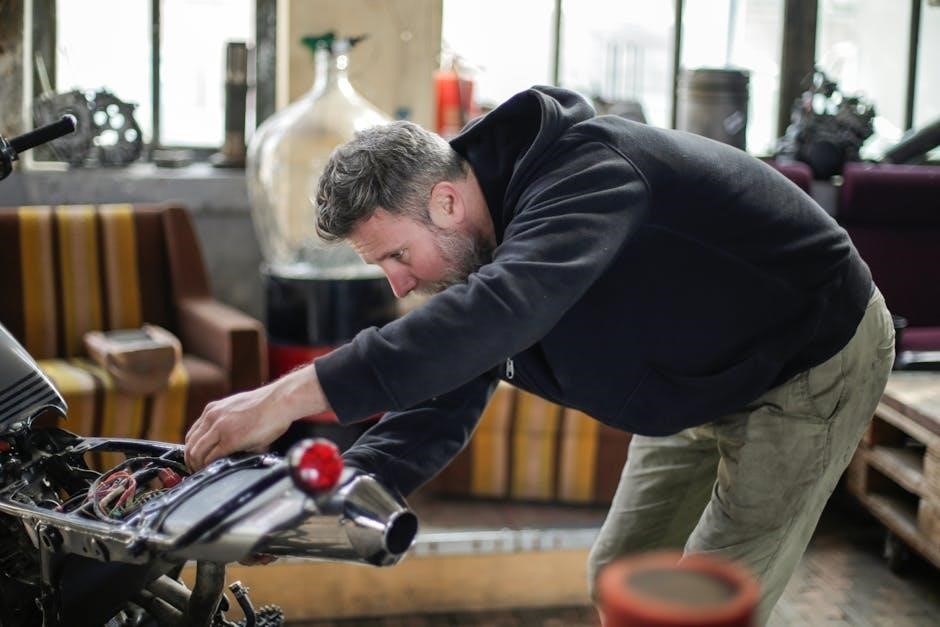
Factors to Consider When Choosing a Motorcycle
Key considerations include lifestyle, usage, commuting needs, and personal skill level. Riders must weigh factors like traffic conditions, off-road use, and their comfort with manual or automatic transmissions.
Lifestyle and Usage
Your lifestyle and how you plan to use the motorcycle are critical factors. For daily commuting in heavy traffic, an automatic motorcycle may offer convenience and reduce fatigue. Conversely, manual transmissions are often preferred for their control and connection to the ride, making them ideal for enthusiasts or those who enjoy spirited driving. Consider whether your primary use will be urban, touring, or off-road adventures.
Commuting and Traffic
For commuting in heavy traffic, automatic motorcycles are advantageous as they reduce the need for constant gear shifts, minimizing rider fatigue. Manual transmissions, however, offer better fuel efficiency and more control, which can be beneficial in predictable traffic patterns. The choice depends on personal preference and the specific demands of your daily commute, such as start-and-stop traffic versus steady flows.
Off-Road vs. On-Road Use
Manual motorcycles are often preferred for off-road use due to their precise control over gear shifts, which is crucial for navigating challenging terrains like steep inclines or rough surfaces. Automatic motorcycles, while less common in off-road settings, can still perform well if designed for such purposes. On-road use, particularly in heavy traffic, may favor automatics for their ease of operation, while manuals offer better fuel efficiency and responsiveness on paved roads.
Personal Preference and Skill Level
Riders’ choices between automatic and manual motorcycles often hinge on personal preference and skill level. Manual transmissions appeal to experienced riders who enjoy the control and engagement of shifting gears. For beginners or those seeking ease, automatics simplify the learning process. Skill level plays a significant role, as manuals require coordination and practice. Ultimately, matching the motorcycle type to the rider’s comfort and experience ensures a safer and more enjoyable experience.

Popular Models of Manual and Automatic Motorcycles
Popular manual motorcycles include the Yamaha FZ-6R and Kawasaki Ninja, while automatic models like the Honda Gold Wing and BMW C 650 GT offer smooth, clutch-free riding.
Best Manual Motorcycles for Beginners
The Honda Rebel 500, Yamaha MT-07, and Kawasaki Ninja 400 are top choices for beginners learning manual transmissions. These bikes are lightweight, easy to handle, and offer smooth clutch control, making them ideal for mastering shifting gears. Their manageable power delivery and ergonomic design reduce fatigue, allowing new riders to focus on technique and confidence-building. These models strike a perfect balance between performance and accessibility for those new to manual motorcycles.
Top Automatic Motorcycles in the Market
Leading automatic motorcycles include the Honda DCT Africa Twin, Yamaha FJR1300, and Suzuki Burgman 400. These models feature smooth, clutch-free operation, ideal for urban commuting and long-distance touring. The Honda DCT offers seamless gear shifts, while the Yamaha FJR1300 combines comfort with powerful performance. The Suzuki Burgman excels in practicality, making automatic motorcycles a convenient choice for riders seeking ease of use without sacrificing performance or style.

Maintenance and Repair of Motorcycle Transmissions
Regular maintenance is crucial for both automatic and manual transmissions. Check fluid levels, inspect for leaks, and replace worn-out parts. Addressing issues early prevents costly repairs.
Maintenance Tips for Manual Transmissions
Regular maintenance is essential for manual motorcycle transmissions. Check transmission fluid levels and top up as needed. Inspect for leaks and replace worn-out gaskets or seals. Clean or replace the air filter to ensure proper engine performance. Lubricate gears and bearings regularly to prevent wear. Avoid riding in high gear at low speeds, as this can strain the transmission. Monitor clutch cable tension and adjust when necessary. Replacing the clutch plate and gear oil at recommended intervals ensures smooth gear shifts and longevity.
Maintenance Tips for Automatic Transmissions
For automatic motorcycles, regular fluid checks are crucial. Use the recommended ATF (Automatic Transmission Fluid) and replace it as per the manufacturer’s schedule. Inspect the transmission belt or chain for wear and tear, replacing it if necessary. Clean the cooling system to prevent overheating. Avoid extreme accelerations or decelerations to reduce strain. Check for any software updates and ensure the transmission control module is functioning properly. Regular servicing by a professional can prevent costly repairs and maintain smooth operation.
Signs of Transmission Issues
Look for slipping or delayed gear shifts, unusual noises like clunking or whining, and a lack of smooth acceleration. Leaking fluid, especially red or brown, indicates a potential seal failure. If the motorcycle hesitates or jerks between gears, it may signal internal wear. In automatics, unexpected downshifts or failure to engage gears are red flags. Address these symptoms promptly to prevent major repairs and ensure rider safety.
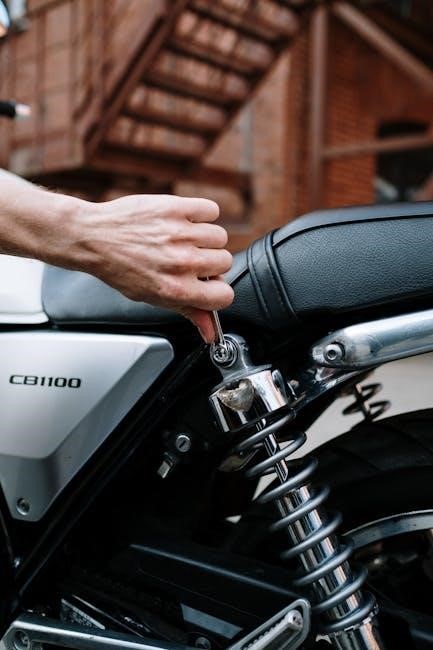
Cost Considerations
Manual motorcycles typically have lower purchase prices and maintenance costs compared to automatics, with better fuel efficiency, reducing long-term expenses for riders prioritizing affordability and performance.
Purchase Price Comparison
Manual motorcycles generally have lower purchase prices compared to automatic models, making them more accessible for budget-conscious buyers. Entry-level manual bikes often start around $5,000, while automatic motorcycles typically begin at a higher price point, sometimes exceeding $10,000 for advanced models. This price gap reflects the added complexity and technology in automatic transmissions, though both options offer value depending on the rider’s preferences and needs.
Maintenance and Repair Costs
Manual transmissions typically require less maintenance and have lower repair costs due to their simpler mechanical design. Fewer components mean reduced likelihood of failures, and parts are generally more affordable. Automatic motorcycles, while convenient, often incur higher maintenance and repair expenses due to complex systems like hydraulic circuits and torque converters, which can be costly to replace. Regular servicing is essential for both types to ensure longevity and performance.
Fuel Efficiency and Running Costs
Manual motorcycles often offer better fuel efficiency due to direct control over gear shifts, optimizing engine performance. Automatics, while convenient, may consume slightly more fuel because of the added weight and complexity of their systems. Running costs for manuals are generally lower, but automatics can still be economical, especially in heavy traffic where constant shifting is minimized, balancing out overall expenses for riders prioritizing ease of use.

The Future of Motorcycle Transmissions
Advancements in transmission technology are expected to enhance efficiency and performance. Automatic systems may become more prevalent, while manuals evolve with smarter clutchless designs, catering to diverse rider preferences and environmental demands.
Technological Trends
Motorcycle transmissions are evolving with advancements like dual-clutch systems, continuously variable transmissions (CVTs), and smart clutch technologies. These innovations aim to enhance efficiency, performance, and rider comfort. Automatic systems are becoming more refined, while manual transmissions are adopting clutchless shifting for convenience. Electrification and hybrid models are also emerging, blending traditional gears with electric powertrains. These trends reflect the industry’s shift toward smarter, eco-friendly, and adaptive solutions to meet modern rider demands and environmental regulations.
Impact on the Motorcycle Industry
The rise of automatic and semi-automatic transmissions is reshaping the motorcycle industry, offering riders more options. This shift is driving innovation, with manufacturers investing in advanced technologies to cater to diverse preferences. As automatic models gain popularity, the market is expanding, appealing to new riders and experienced enthusiasts alike. This evolution is prompting a reevaluation of traditional manual designs, ensuring the industry remains competitive and relevant in a changing landscape.
Motorcycles are available with manual or automatic transmissions, each offering unique advantages. Manual transmissions provide control and efficiency, while automatics offer convenience and ease of use. Riders’ preferences, skill levels, and lifestyles influence their choice. Proper maintenance is crucial for both types to ensure longevity and performance. Understanding these differences helps riders make informed decisions, enhancing their overall motorcycling experience and safety on the road.
Final Thoughts and Recommendations
When deciding between automatic and manual motorcycles, consider your experience, lifestyle, and riding environment. Manual transmissions offer control and efficiency, ideal for experienced riders. Automatics provide ease of use, perfect for beginners or urban commuting. Ultimately, choose the option that aligns with your preferences and skill level for an optimal motorcycling experience.